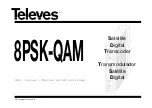
WSPR Without Tears
What makes it really interesting is that WSPR is optimized for operating at very low power. For
example, it's normal to transmit with 200 mW from the US and be received in Australia or Europe.
There are hams all over the world with WSPR receivers. They record what they receive in a central
database that can be queried over the Internet. So you put your WSPR transmitter on the air and
monitor its performance from the Internet. Monitoring WSPR is sort of addictive. It's fascinating to see
what effect time of day, seasons, and weather have on propagation.
There is a wide array of choices for setting up a WSPR beacon. The most obvious and possibly the
simplest is to use your regular transceiver. This requires a computer and sound card connection. Most
of us have at least one computer in the shack and many of us are already using digital modes, so the
equipment is already in place to run WSPR. All you have to do is download the software (free) and
you're off to the races. This approach works well and the price is right if you're already are set up for
digital modes. Even if you're not set up for digital modes, the interface between your transceiver and
computer can be had for less than $100.
Using your base station for WSPR is an excellent approach. The downside is that you are tying up your
station while WSPR is on, so leaving WSPR on for an extended length of time gets in the way of radio.
A second point, the output power of many transceivers can't be adjusted below 5 watts. An output
power of 5 watts will certainly work, but it's interesting to see how little power you can get away with
and the useful power range is a lot less than 5 watts.
The alternative to using your regular station for WSPR is to have a completely separate WSPR station.
That's a lot more realistic when you're dealing with output powers in the range of milliwatts. When we
started down this path we looked at different approaches. One approach we looked at was high quality
and well done, but there are some operational complaints we had with it that we wanted to fix. This is
our version for a fix.
Approach
We found an alternate approach using a Raspberry Pi (Pi) computer to generate WSPR transmissions. A
Pi is about the size of a deck of playing cards and costs about $40. It has an amazing amount of
computing power for something so small and so cheap. It runs the Linux operating system.
The Pi can be configured to generate the WSPR signal without any external components! That's just
amazing to me. Somebody figured out how to modulate the clock/oscillator and generate a WSPR
signal. The Pi will also set the time by calling an NTP server and use the time information to adjust the
frequency, eliminating the need for any calibration or timing setup.
There are two problems with using the Pi for WSPR. First, the output signal is a square wave with
harmonics from here out to next Tuesday. A low pass filter is necessary to keep other hams and the
TAPR (c) 2018-2019 “WSPR Without Tears” 2 Of 20 Version 2.1 05/20/2019



































